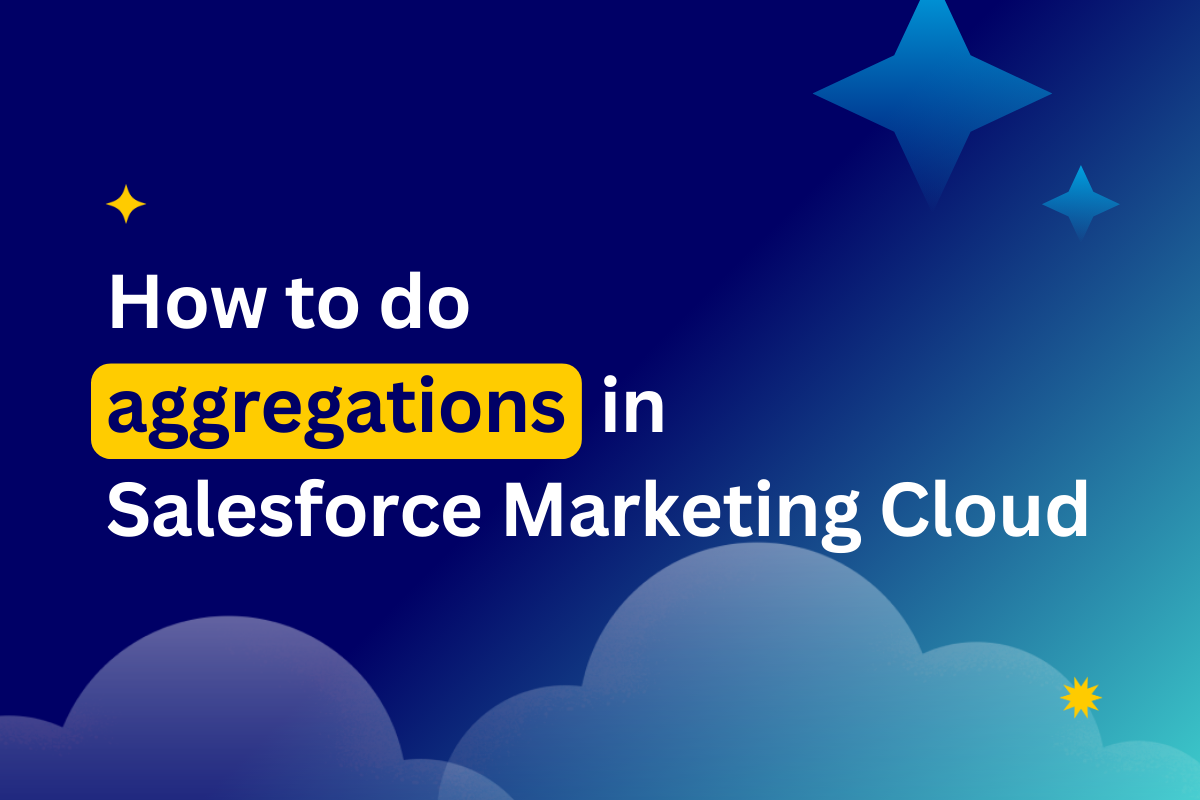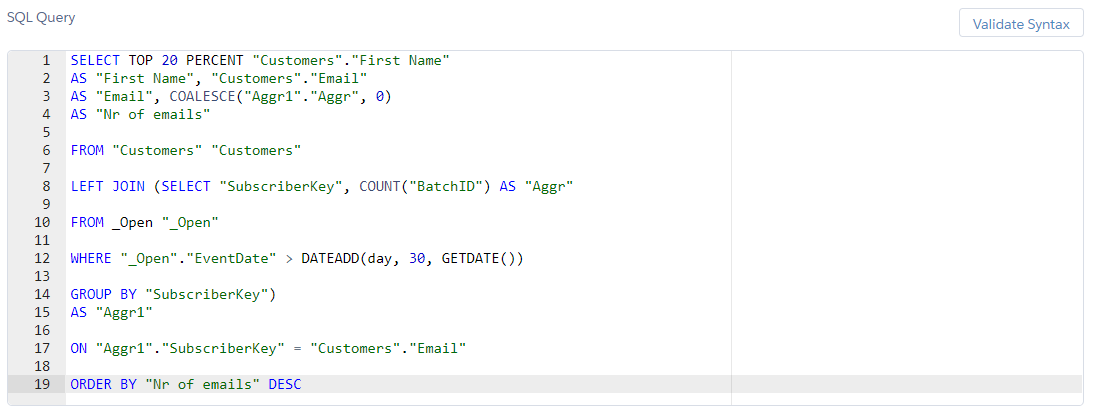
How to do aggregations in Salesforce Marketing Cloud? - DESelect Blog
Would you like to be able to find the number of orders each customer has made in a certain period of time? Or calculate the average order value for each customer? Or maybe you want to count the number of emails sent to each subscriber in the last 30 days? All that and more is possible with the aggregation functionality in Salesforce Marketing Cloud.
In this article, we will explain how to use aggregations in Salesforce Marketing Cloud (SFMC) using SQL and DESelect.
How to use aggregations in SFMC using SQL
SQL is great at aggregating data the way you might in a pivot table in Excel. The functions are similar to what you’ll find in Excel or certain analytical tools. For instance, The GROUP BY statement groups rows that have the same values as summary rows, like “find the number of customers in each country”.
The GROUP BY statement is often used with aggregate functions (COUNT(), MAX(), MIN(), SUM(), AVG()), to group the result-set by one or more columns. Here you can find a brief explanation of what each function means:
- AVG – calculates the average of a set of values
- COUNT – counts rows in a specified table or view
- MIN – gets the minimum value in a set of values
- MAX – gets the maximum value in a set of values
- SUM – calculates the sum of values.
In this article, we’re going to dig deeper into the COUNT aggregation that allows you to do a count on a data extension or data view and store the results in your target data extension.
In the scenario we’re going to demonstrate, we’d like to know the number of times each subscriber has opened an email in the last 30 days. On top of that, we’d also like to limit the result to the first 20% of subscribers.
Here’s how the SQL query for the following scenario will look.

(SQL query using Aggregations)
In our example, we’re using the Customers data extension along with the data view _Open. Normally, an aggregation is only a part of the segmentation a marketer has to perform. However, for non-technical marketers it can sound like a challenge. Fortunately, there are alternatives to writing SQL in SFMC if you want to use aggregations… like DESelect!
How to use aggregations in SFMC using DESelect
In the video below you can find a step-by-step guide to using aggregations in DESelect.
For convenience, DESelect offers different screens depending on the level of the marketer’s maturity. For instance, if you don’t know how your data model is set up exactly, you can use the ‘Basic’ screen, where the relations between your data extensions are already pre-defined. In the video, for example we’re using this screen to create an aggregation. However, if you are more confident with your data model, you can use the advanced screen. You can read more about how to create a segment using the advanced aggregation screen here.
If you’d like to book a live demo to see how DESelect avoids the need for code in your advanced segmentation, one of our experts would love to help you.
Conclusion
In this article, we explained how to use aggregations in Salesforce Marketing Cloud using SQL and the no-code alternative, DESelect. If you want to see DESelect live and leverage aggregations with an easy drag-and-drop, book a demo with one of our experts.
- How to use aggregations in SFMC using SQL
- How to use aggregations in SFMC using DESelect
- Conclusion
Latest Articles
-
How to Measure the ROI of AI Copywriting Tools
How to Measure the ROI of AI Copywriting Tools AI copywriting tools have become essential for SaaS and consumer brands alike, not just for cutting the cost of content creation but also for winning new customers. But measuring the ROI of these tools goes beyond counting words generated or hours saved. Today, ROI also includes […]October 24, 2025The Future of Generative AI in Copywriting
The Future of Generative AI in Copywriting Generative AI is already rewriting how copywriters, marketers, and brands create content. But the future? It’s far bigger than “faster blogs and ads.” The next decade of AI in copywriting will go beyond efficiency; it will reshape creativity itself, reframe how brands tell stories, and even redefine the […]October 23, 2025Why AI Outputs Often Feel Too Generic
Why AI Outputs Often Feel Too Generic Content personalization has always been the holy grail of marketing. Delivering the right message to the right person at the right time can dramatically improve engagement, conversion rates, and trust. But scaling personalization across multiple buyer personas, industries, and customer journeys has traditionally been expensive and time-consuming. Generative […]October 23, 2025Debunking the Biggest Misconceptions About AI Copy
Debunking the Biggest Misconceptions About AI Copy Artificial intelligence has officially gone mainstream in the marketing and sales world. Copywriting tools powered by AI are now being used everywhere: from email campaigns to product descriptions, ad copy to blog posts. But with this rise comes a swirl of myths, fears, and conspiracy theories about how […]October 17, 2025Join our newsletter to receive updates and helpful SFMC guides.










